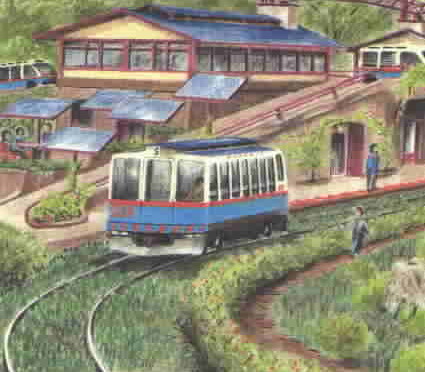Unedited version published in Marin Independent Journal 7-14-98. Pictures added.
Marin Voice
With no train can we really clean the air?
Dwayne Hunn
Let’s ponder an imaginary debate on the following topic. “Is the Marin Conservation League good for the world?”
Team Beemers’ Jennifer Comfy, of Marin’s Platitude High, opens the debate as Team Bikers of Oakland’s Tanning Vocational look on with big eyes.
“The Conservation League merges all those individuals and groups who work to ensure that tomorrow’s children have an environment that blooms with flowers, billows with fresh ocean breezes, cascades with hiking trails and soothes our eyes with scenic vistas. Without such a league of the environmentally conscious, not only would the greenery of our lands and blue of our skies fade and darken, but the tranquility of our lives and creativity it provides our minds would dissipate. Working locally, these courageous environmentalists institute programs that make the universe an extraordinary partaking….”
While shuffling to the podium, the Bikers’ Dirk Maloney responds, “Well, beam me and my crew up to your world, where life’s a beach and everyone bathes in sunshine and stellar lights. Conservationists devour resources to save you the blue and green in wavy fields, while leaving others to view concrete and asphalt etched by bars and orphanages…
Zane Farr, the supervising teacher interrupts, “Refrain from being personal. Use factual references to make your points.”
Bobbing his head, Dirk continues, “A true environmentalist measures his works by how they impact the world beyond the greenery of their county, their hiking trails and their tranquility. He learns to see beyond a few pretty colors and local scenery when he views the impacts of his efforts. Thank you.”
“Specifics points, Ms. Comfy,” interjects Mr. Farr.
“In what is often referred to as Marvelous Marin, we have a richness and beauty of life creditable to the environmental movement. Years ago we stopped BART. Recently we stopped hundreds of beautiful, bucolic St. Vincent’s / Silveira acres from being plied with development, so that our scenic, serene view from Highway 101 will remain. By disallowing a future train stop and drastically cutting St. Vincent’s developmental potential, we insured minimal nature impacts. It is such farsightedness that provides for a heavenly, ecologically sound atmosphere.”
“Wonderful vision,” Dirk grumbles. “While here in Oakland none of your Marin Community Foundation money helps our serenity. Yet that money continues supporting Marin’s sereneness deprived environmental organizations. We support Amtrak and BART to reduce the pollutants your self-imposed congested freeways cause. Your Golden Drawbridge makes comfortable lives for the rich and famous, while the East Side Bridge relives West Side Stories. Oakland scrapes for money to make our poverty programs work and spread rail transit, because we want hard working parents to spend as much time as possible with their kids. Rail-less, you force hard working families to pollute and commute hither and yon, trading thousands of parental quality hours for latch-key kiddom.
“You think you’re saving the neighboring pearly mouse and pretty bird, while forcing working folk to exhaust stuff in the air that hurts those same and other critters outside your neighborhood. The commute time you force on parents increases the likelihood their latch-kids will do time.”
Rolling her eyes, Jennifer retorts, “Conservation, Mr. Maloney, is not about juvenile delinquency. It is about saving the environment, so that future generations can enjoy its wonders…”
“Right, Ms. Comfy. For you there is no connection and I’m confused… Someday rest your BMer for a rickety bike adventure on some mean streets or sweat in some poor country, where land use planning for million dollar estates lags far behind putting 1500 calories on tomorrow’s plate. Then come back and explain to me why your environmental land use crusade to hurt middle class Americans, their kids, and the world’s air is so groovy good for the rest of the earth?”
Mill Valley’s Dwayne Hunn sometimes supervises debates, rides bikes, and gets confused.
“Bad Train….”
- Developers need a new strategy
- Collected wisdoms on why Marin housing is so expensive:
- Federal bay refuge simply is too much
- A ’golden opportunity’ for whom?
- Preservation proposal is elitist
- St Vincent’s is a rare opportunity
- ‘Smart’ planning needed in Marin
- I see San Rafael in 2020, and it works
- 10 questions for San Rafael
- Oh, God, have mercy on our failures
- …but, from where I sit, they’re part of the problem
- Downzoning can punish community
- With no train can we really clean…
- All aboard! The future…
- Marin, why not think ‘regional’?
- Apathy never fixes anything
- Marin power/a closer look
- Pedestrian Pockets II
- Interviewing Angelo Siracusa — Bay Area Council boss
- Pedestrian pockets
- Everyone wants transit?
- NEH, NBTMA, County letters on Hamilton Proposed Development
- Traffic reducing proposals
- Points in favor of Hamilton
- Building a better Marin
- Rail/Highway alternative best with development “pockets’
- East San Rafael’s needs
- Address our housing needs
- Visionary Leaders needed
- Innovations at Novato’s Skylark project

